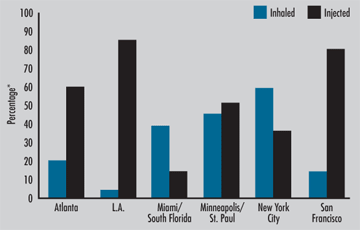
|

Heroin is an illegal, highly
addictive drug. It is both
the most abused and the
most rapidly acting of the opiates.
Heroin is processed from
morphine, a naturally occurring
substance extracted from the
seed pod of certain varieties of
poppy plants. It is typically sold
as a white or brownish powder
or as the black sticky substance
known on the streets as "black
tar heroin." Although purer heroin
is becoming more common,
most street heroin is "cut" with
other drugs or with substances
such as sugar, starch, powdered
milk, or quinine. Street heroin
also can be cut with strychnine or other poisons. Because heroin
abusers do not know the actual
strength of the drug or its true
contents, they are at risk of
overdose or death. Heroin also
poses special problems because
of the transmission of HIV and
other diseases that can occur
from sharing needles or other
injection equipment.
What is the scope of heroin
use in the United States?
According to the 2003
National Survey on Drug
Use and Health, which
may actually underestimate illicit
opiate (heroin)
use, an estimated
3.7 million
people had used
heroin at some
time in their
lives, and over
119,000 of them
reported using it
within the month
preceding the
survey. An estimated
314,000
Americans used heroin in the past year, and the
group that represented the highest
number of those users were
26 or older. The survey reported
that, from 1995 through 2002, the
annual number of new heroin
users ranged from 121,000 to
164,000. During this period, most
new users were age 18 or older
(on average, 75 percent) and
most were male. In 2003, 57.4
percent of past year heroin users
were classified with dependence
on or abuse of heroin, and an
estimated 281,000 persons
received treatment for heroin
abuse.
According to the Monitoring
the Future survey, NIDA's
nationwide annual survey of
drug use among the Nation's
8th-, 10th-, and 12th-graders,
heroin use remained stable from
2003 to 2004. Lifetime heroin
use measured 1.6 percent among
8th-graders and 1.5 percent
among 10th- and 12th-graders.
The 2002 Drug Abuse Warning
Network (DAWN), which collects
data on drug-related hospital
emergency department (ED)
episodes from 21 metropolitan
areas, reported that in 2002,
heroin-related ED episodes
numbered 93,519.
NIDA's Community Epidemiology
Work Group (CEWG), which
provides information about the
nature and patterns of drug
use in 21 areas, reported in its
December 2003 publication that
heroin was mentioned as the
primary drug of abuse for large
portions of drug abuse treatment
admissions in Baltimore, Boston, Detroit, Los Angeles, Newark,
New York, and San Francisco.
How is heroin used?
Heroin is usually injected,
sniffed/snorted, or smoked.
Typically, a heroin abuser
may inject up to four times a
day. Intravenous injection provides
the greatest intensity and
most rapid onset of euphoria
(7 to 8 seconds), while intramuscular
injection produces a
relatively slow onset of euphoria
(5 to 8 minutes). When heroin
is sniffed or smoked, peak
effects are usually felt within 10
to 15 minutes. NIDA researchers
have confirmed that all forms
of heroin administration are
addictive.
|

Source: Community Epidemiology Work Group, NIDA, December 2003, Vol. II.
*Includes first half 2003 data from treatment facilities. |
Injection continues to be the predominant method of
heroin use among addicted
users seeking treatment; in many
CEWG areas, heroin injection is
reportedly on the rise, while
heroin inhalation is declining.
However, certain groups, such
as White suburbanites in the
Denver area, report smoking or
inhaling heroin because they
believe that these routes of
administration are less likely to
lead to addiction.
With the shift in heroin abuse
patterns comes an even more
diverse group of users. In recent
years, the availability of higher
purity heroin (which is more
suitable for inhalation) and the
decreases in prices reported in
many areas have increased the
appeal of heroin for new users
who are reluctant to inject.
Heroin has also been appearing
in more affluent communities.
|

|
|